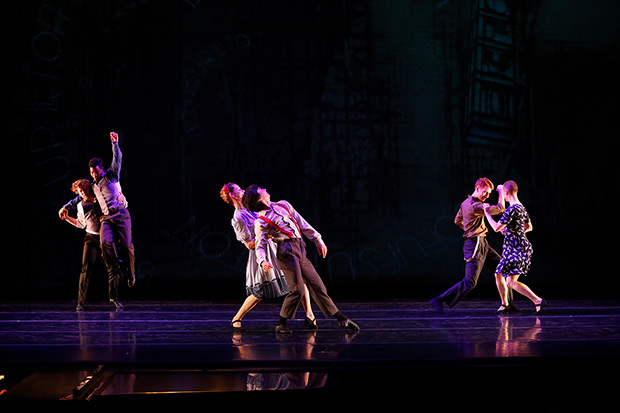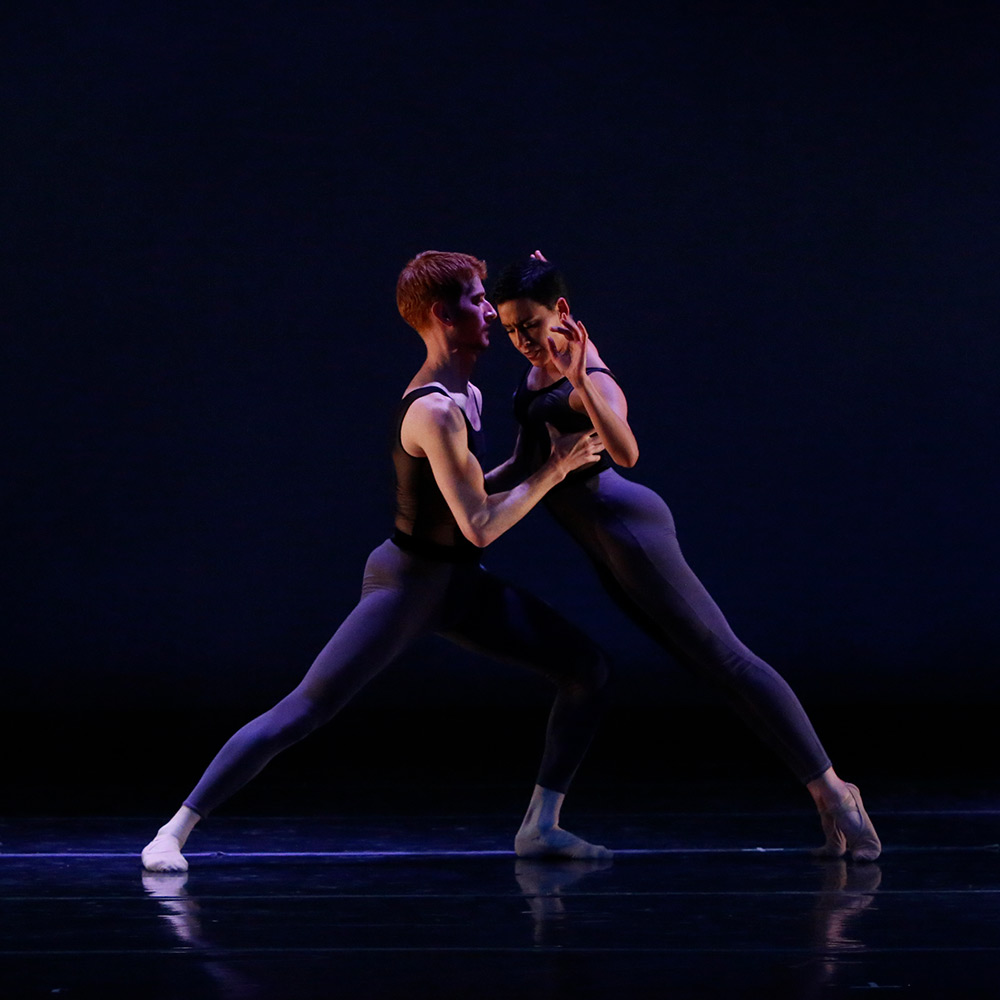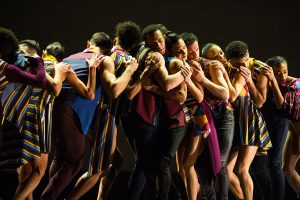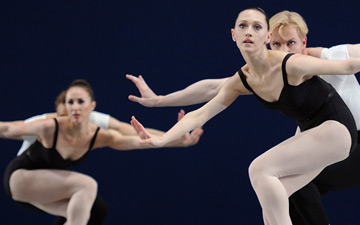
© Matt Haber. (Click image for larger version)
Mark Foehringer Dance Project | SF
Like an Ox on the Roof, Simple Symphony, Another Time, Concerto Grosso
★★★✰✰
San Francisco, Cowell Theater
22 March 2019
mfdpsf.org
fortmason.org
Mark Foehringer Dance Project | SF is known in San Francisco for its terrific children’s dance concerts. Every December, they stage Nutcracker Sweets, Artistic Director Mark Foehringer’s abridged, fifty-minute adaptation of The Nutcracker, ideal for the youngest of dance fans. And recently the twenty-three-year-old troupe applied that same formula to the Alice in Wonderland story, creating a shorter version, accessible to the entire family. But anyone who was at the Cowell Theater on Friday night can attest that children’s programming is only one strand of MFDP’s DNA. Foehringer’s ambitious mixed repertory program of three premieres (all with live music) and one restaging revealed a company with deep artistic breadth and impressive technical acumen. In fact, the pure dance talent coupled with the sensational live music was well worth the trip to the theater on a dreary SF evening. The choreography, though, was a little uneven.
By far, the highlight of Foehringer’s Simple Symphony was the string ensemble, Friction Quartet. Their interpretation of Benjamin Britten’s music, with its fanciful chapters, grand episodes and plucky interludes, was astonishing – such emotion, verve and fortitude. Unfortunately, that wide lens wasn’t reflected in the choreography. Yes, we did have a few costume changes, and the conceptual splatter collage on the back cyclorama shifted color palettes, from grays to reds to rainbow. But the physical vocabulary stayed more or less at one dynamic level throughout. Jamielyn Duggan and Calvin Thomas’ pattern of fast turns and staccato footwork did inject some attack and urgency into the scene, but it was all too brief. And some of Symphony’s choreographic transitions (both in partnering and within larger phrases) felt rather clunky, which made establishing tonal nuance a real challenge. But to be fair, the dance was supposed to be a quintet and ended up being danced by four. During a pause later in the program, Foehringer explained that one of the performers had fallen ill just the night before. So, it’s hard to know whether Symphony’s tones and transitions would have been different with a complete cast.

© Matt Haber. (Click image for larger version)
In contrast, the premiere of Another Time, danced by Allie Papazian, Sarah Cecilia, David Calhoun and Adonis Damian Martin Quiñones, had smoothness and emotional range to spare. As smoke billowed onto the stage and pianist Daniel Glover played the first notes of Franz Liszt’s Consolations, an undeniable sense of reflective dreaming washed over the room. At first, the four were together in the space, walking slowly and taking in the heady atmosphere. But eventually, they paired up (Papazian with Quiñones, Cecilia with Calhoun) and from there, a series of intoxicating contemporary duets unfolded. Each pair explored a mélange of movement possibilities, delicately extending their arms and legs and curving their spines in curious delight. Directions shifted, as did the partnership’s base of support – they would take turns leaning against one another and lifting each other in space. Time had a winning combination of serenity and inquiry. And it was beautifully communicated by the entire quartet – not a single moment of clunkiness in sight.
Up next was the centerpiece of the program, Foehringer’s third and final premiere of the night, Like an Ox on the Roof. Inspired by an actual Paris club, this ensemble work seeks to transport its audience to this bar during the 1920s, where shenanigans ensue amongst its eccentric patrons. Ox was a lot of fun, and in many ways, very successful in establishing its sense of time and place. Darius Milhaud’s score, a fourhanded piano piece expertly interpreted by Tamami Honma and Glover, embodied the early era with ragtime influences, whimsical melodies and sly, slinky motifs. Layered sepia images and fonts projected on the backdrop (by Frederic O. Boulay) oozed nostalgia, as did Duggan’s costumes. The men sported vests and suspenders, the women, knee-length floral dresses and character shoes, and as Ox’s diva, Cecilia wore a sparkling mint-green chiffon gown. But I don’t know that the choreography itself contributed much to the historic setting. Save a few grapevines, Charleston steps and some sultry slides and extensions for Cecilia’s character, the movement didn’t particularly reflect 1920s flavor or quality. And I had read that Ox also had a political message, which I can’t say I saw.

© Matt Haber. (Click image for larger version)
As the program closed, it was evident that MFDP had saved the best for last. 2000’s Concerto Grosso was the only piece with recorded music, but the choreography (and the dancing) was so good that it didn’t matter. Set to a multi-chapter suite by Ernest Bloch, the octet is a love letter to contemporary movement vocabulary; a fresh, unfussy look at curves, lines, arcs and shapes. It doesn’t attempt to tell a story nor convey a particular mood, it is all about sharing physical language. High throttle jumps counterpointed percussive contractions; rebounding falls met with strong diagonal lines; off-center passé balances fed into jazz runs. The cast impressed with their infectious, uplifting energy, technical clarity, forward momentum and enviable endurance. Standouts included Dennis Adams, who led Grosso’s charge with confidence and skill and Danielle Serio, a student at San Jose State, who more than held her own replacing Emily Hansel at the last minute.

















You must be logged in to post a comment.